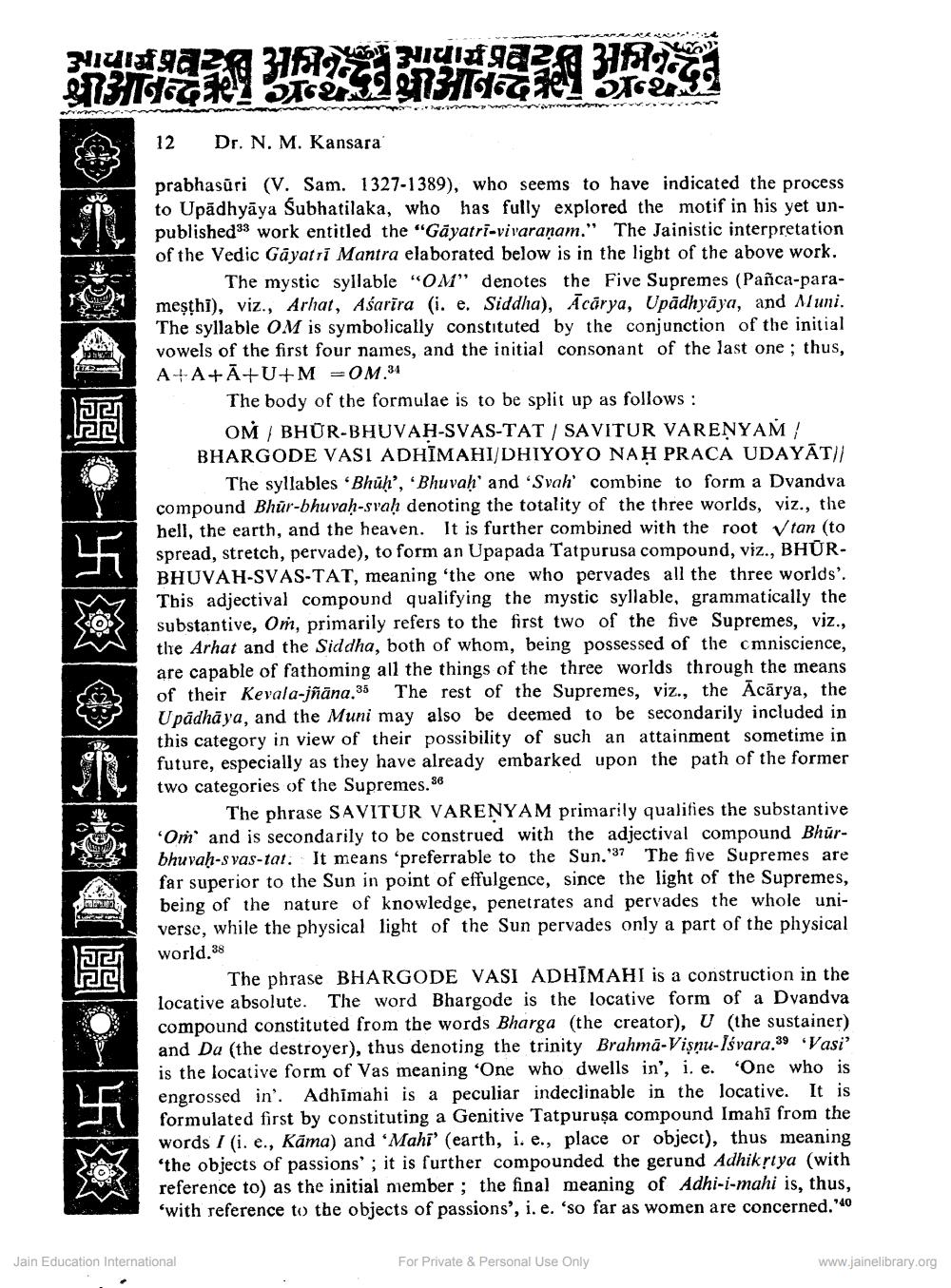Book Title: Vedic Gayantri Mantra and its Metemorophosis In The Jainism Author(s): N M Kansara Publisher: Z_Anandrushi_Abhinandan_Granth_012013.pdf View full book textPage 5
________________ Bulgaz E ulf 982 370 श्रीआनन्दान् श्रीआनन्द अन्य SUN 11 NUL 12 Dr. N. M. Kansara AO prabhasűri (V. Sam. 1327-1389), who seems to have indicated the process to Upādhyāya Subhatilaka, who has fully explored the motif in his yet unpublished 3 work entitled the “Gāyatri-vivaranam." The Jainistic interpretation of the Vedic Gayatri Mantra elaborated below is in the light of the above work. The mystic syllable "OM" denotes the Five Supremes (Panca-parameșthi), viz., Arhat, Ašarira (i. e. Siddha), Ācārya, Upadhyāya, and Muni. The syllable OM is symbolically constituted by the conjunction of the initial vowels of the first four names, and the initial consonant of the last one ; thus, A+ A+Ā+U+M =OM.34 The body of the formulae is to be split up as follows: OM / BHÜR-BHUVAH-SVAS-TAT / SAVITUR VARENYAM BHARGODE VASI ADHĪMAHI/DHIYOYO NAŇ PRACA UDAYĀT// The syllables 'Bhūh', 'Bhuvah' and 'Svah combine to form a Dvandva compound Bhūr-bhuvaḥ-svah denoting the totality of the three worlds, viz., the hell, the earth, and the heaven. It is further combined with the root Vtan (to spread, stretch, pervade), to form an Upapada Tatpurusa compound, viz., BHŪRBHUVAH-SVAS-TAT, meaning 'the one who pervades all the three worlds'. This adjectival compound qualifying the mystic syllable, grammatically the substantive, Om, primarily refers to the first two of the five Supremes, viz., the Arhat and the Siddha, both of whom, being possessed of the cmniscience, are capable of fathoming all the things of the three worlds through the means of their Kevala-jñāna,35 The rest of the Supremes, viz., the Ācārya, the U pādhāya, and the Muni may also be deemed to be secondarily included in this category in view of their possibility of such an attainment sometime in future, especially as they have already embarked upon the path of the former two categories of the Supremes. 38 The phrase SAVITUR VARENYAM primarily qualifies the substantive Om and is secondarily to be construed with the adjectival compound Bhūrbhuvah-s vas-tat. It means 'preferrable to the Sun.'37 The five Supremes are far superior to the Sun in point of effulgence, since the light of the Supremes, being of the nature of knowledge, penetrates and pervades the whole universe, while the physical light of the Sun pervades only a part of the physical world.38 The phrase BHARGODE VASI ADHIMAHI is a construction in the locative absolute. The word Bhargode is the locative form of a Dvandva compound constituted from the words Bharga (the creator), U (the sustainer) and Da (the destroyer), thus denoting the trinity Brahma-Vişnu-Isvara.39 Vasi' is the locative form of Vas meaning 'One who dwells in', i. e. 'One who is engrossed in'. Adhimahi is a peculiar indeclinable in the locative. It is formulated first by constituting a Genitive Tatpurușa compound Imahi from the words I (i. e., Kāma) and Mahi' (earth, i. e., place or object), thus meaning 'the objects of passions'; it is further compounded the gerund Adhikriya (with reference to as the initial member, the final meaning of Adhi-i-mahi is, thus, 'with reference to the objects of passions', i.e. ‘so far as women are concerned."40 Jain Education International For Private & Personal Use Only www.jainelibrary.orgPage Navigation
1 ... 3 4 5 6 7 8 9
